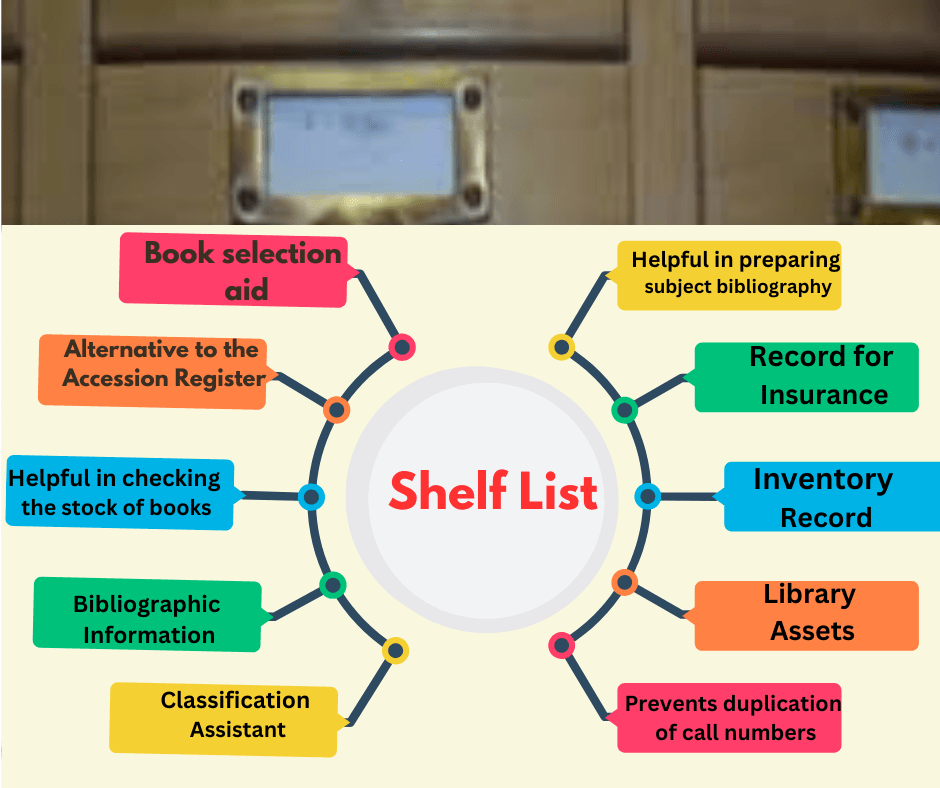The modern classification of library catalogs, the shelf list, plays an important role in library management. The shelf list is a document of the indexed readings in the library. The shelf list is prepared for the use of library staff in the office. Readers cannot use the shelf list. The shelf list is considered an official record or official catalog. Just as books are arranged or sorted on a shelf, shelf lists are also arranged according to call numbers. Different information scientists or catalog experts have given different definitions.
According to the ALA glossary of library terms, a shelf list is a record of the books in a library arranged in the order in which they stand on the shelves.
The book Technical Service in Libraries, written by prominent librarian and information scientist Maurice F. Tauber and others, states about Shelf List, “A shelf list record is an essential component of the library tools for access to its collection since it shows the material assigned to a particular number. It is an invaluable aid to classification; its classified arrangement makes it a substitute for a more elaborate classified catalog”.
Prominent library and information scientist Susan Gray says in her book Simple Library Cataloging,” A shelf list records the cataloged books in a library arranged in the order in which they stand on the shelves.”
Information scientist Lois Mai Chan says in her book, Cataloging and Classification: An Introduction,” A shelf list is a file of cataloging records arranged by call number.”
Bevery K. Duval & Linda Main, in their book Automated Library Systems, say, “A shelf list is a record of the books in a library. The entries are brief and arranged on cards or sheets in the order of the books on the shelves”.
According to various definitions, a shelf list is an official document of a library collection. It includes a summary of each title of the text. All the bibliographic information that is included in the main text is also given in the shelf list. Additional information is given as the date of order of the library material, date of collection, accession number, price, source, location, and number of copies. All this additional information is mentioned sequentially under the column number on the left side of the catalog card. If there is more than one copy of a book, then the accession number of each copy is to be mentioned in the shelf list.
Functions and Importance of Shelf List:
The main purpose of the shelf list is to maintain an up-to-date record of the indexed books of the library. The Shelf List is mainly prepared for official use in the Technical Preparation Section of the Library. It is maintained to expedite the classification and indexing work and to prevent duplication. It is maintained to expedite the classification and indexing work and to prevent duplication.
The Shelf List can be used as an alternative to the Accession Register. The shelf list plays an important role in checking the stock of library materials. If a book is lost or canceled or is retrenched, the shelf card is removed. A shelf list is a complete list of books indexed by a library or books supplied to the reading room. Therefore, the importance of a shelf list in any library is immense.

The functions and importance of shelf lists are discussed below:
- Book selection aid: Since the shelf list is arranged according to the postal number, the subject-based collection of the reading material can be measured. This shows the success or weakness of a particular subject. As a result, effective steps can be taken in the selection and collection of books. A shelf list can work as a book selection aid.
- Alternative to the Accession Register: The shelf list acts as an alternative to the permanent accession register of the library. In addition to the bibliographic information, some additional information, such as the additional number of a particular book, the date of the library’s acquisition order, the date of acquisition, the price, the source, the location, and the number of copies, can be found through the shelf list.
- Helpful in checking the stock of books: Shelf list helps in finding the overall stock of the library. Shelf list can act as a working material while accounting for books. Taking stock according to the shelf list is very easy. Because the shelf list is arranged in the same way as the books are arranged on the shelf.
- Bibliographic information: The shelf list serves as an indicator of the postal number of the text material. Since the entries are arranged according to the postal number, if the postal number of the book is known, the bibliographic information of the related book can be obtained.
- Classification Assistant: Before assigning a class number to a new book in the library, the shelf list can be checked to see if the book has already been indexed. This speeds up classification and indexing and eliminates the possibility of assigning different class numbers to the same book.
- Classified catalog: Since the shelf list is arranged according to category number, it can be used as a classified catalog.
- Helpful in preparing subject bibliography: Subject bibliography can be prepared at the request of the reader with the help of shelf lists.
- Historical and statistical document of the collection of reading materials: The shelf list serves as a historical and statistical document of the collection of reading materials because it stores all information, including statistics, on all types of reading materials.
- Library Assets: Shelf lists serve as a measure of a library’s collection. The number of copies of a particular book collected in a library can be known through the shelf list.
- Record for Insurance: Shelf List can be used as accident insurance records. It serves as an official record in the case of insurance for man-made accidents.
- Inventory Record: If a book is lost or damaged for any other reason, necessary steps can be taken to reacquire the relevant book by collecting the necessary information from the shelf list.
- Complete documentation of library materials: Shelf lists serve as a complete documentation of library materials. Shelf lists play an important role in the smooth and systematic management of a library.
- Prevents duplication of call numbers: Whenever a new postal number is created for a book, a library staff member takes the help of the shelf list. Because if the book has been in the library before, then the previous postal number has to be taken for the newly acquired book. Otherwise, a different postal number may be given. So the shelf list helps in maintaining the consistency of the call number.
In conclusion, a shelf list is an official record of the books collected by a library. It is mainly prepared and preserved for office use. It contains some additional information through which the overall identity of a book is found. It plays a role in book selection. The shelf list can act as a catalog by arranging it according to the postal number. The list has a contribution in the preparation of a bibliography on any subject. The role of shelf list is immense in completing indexing and classification activities accurately.



